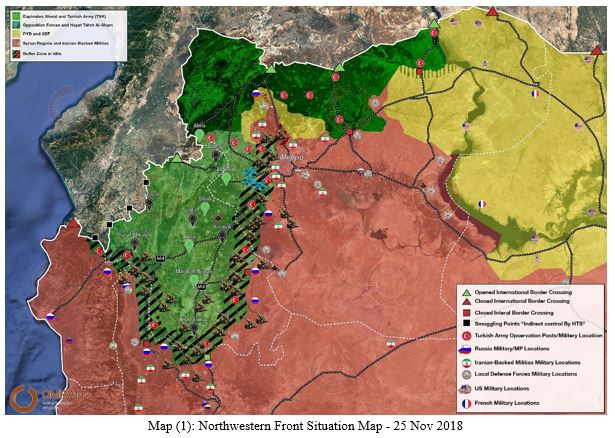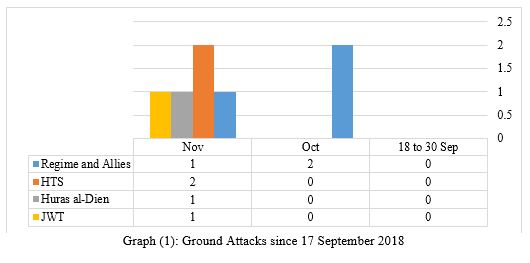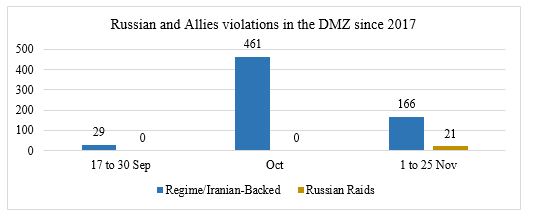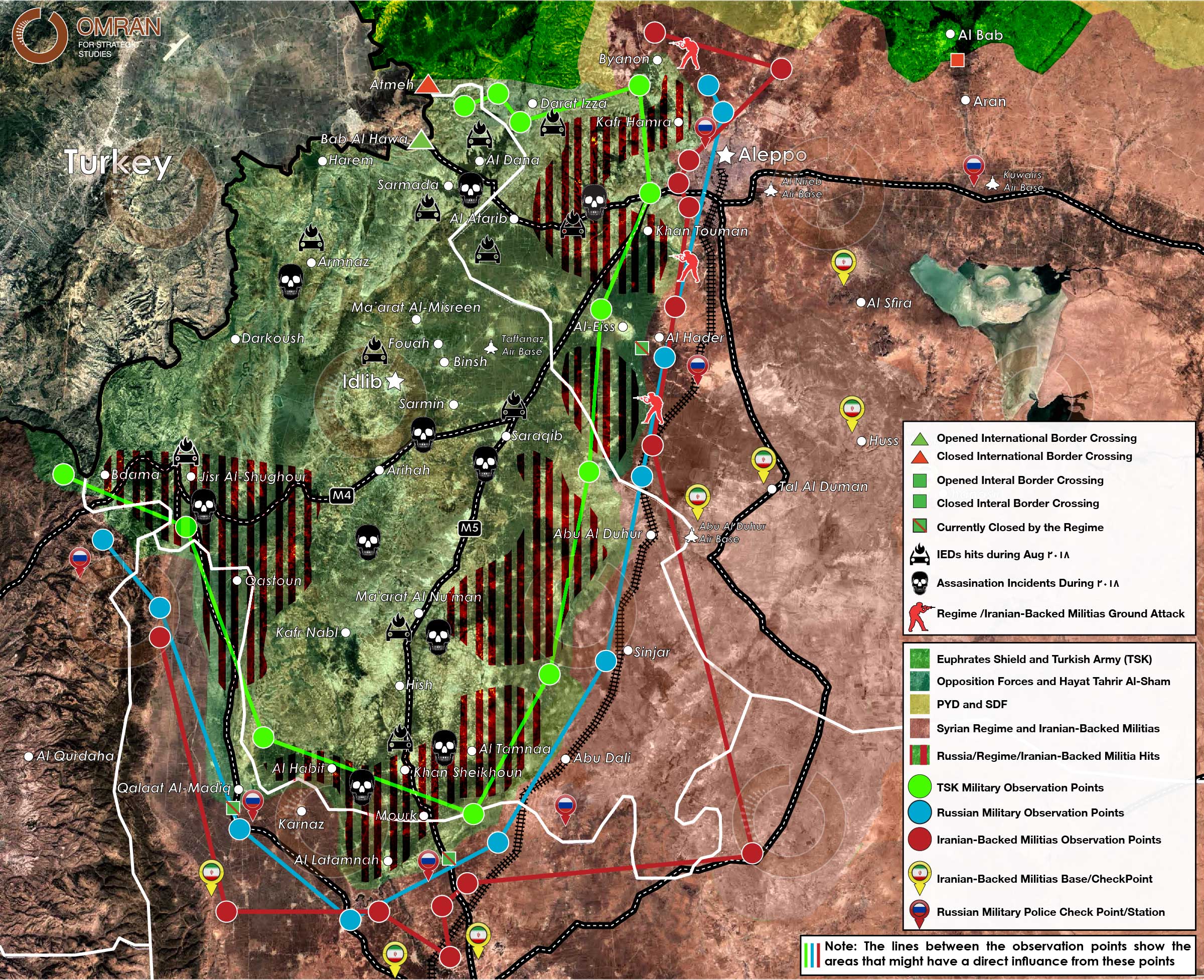Events
An Assessment of Idlib DMZ after 75 Days
Introduction
On 7 Sep 2018, when the Tehran talks ended between Turkey, Russia, and Iran it was obvious that there was no final agreement or disagreement amongst the Astana international players. Everything became more vague except for the postponement of any ground operation by the Regime and it’s allies against Idlib and its surrounding. The Russians decided to postpone any ground attack for the following reasons:
- Buy more time for all the Astana actors to reach for a deal that suits everyone and serves them in a way that does not affect each other's.
- The lack of manpower that is loyal to the Russians in the northwest and that are needed to fill Idlib in case of a ground attack, which will give the chance for the Iranian-backed militias to expand their control to Idlib and Western Aleppo.
Prior to the DMZ agreement, both Turkey and Russia committed to taking several steps in Idlib, which formed the solid base for the initial step of the DMZ. Following are the most significant actions done by Turkey and Russia during the first two weeks of Sep 2018:
- The Turkish observation points cleared their surrounding from any Hayat Tahrir al-Sham (HTS) presence.
- Turkey informed al-Jabha al-Watnia factions to stop coordinating with HTS and not to form any kind of joint military operation rooms.
- Russia announced that it took control of the three internal crossing borders between regime and opposition areas "Abu al-Duhur, Mourk, and Qalat al-Madiq," and informed the 4th division and LDF forces to evacuate the area.
The DMZ Specifications
On 17 Sep 2018, Putin and Erdoğan held a meeting regarding Idlib and agreed to establish a DMZ in Idlib, Northern Hama, and Western Aleppo with the following specifications:
- 15 to 20 km zone running along the borders of the Idlib region will be safe from Syrian and Russian air force attack and will be in place by 15 October.
- Heavy weapons including tanks, mortars, and artillery will be withdrawn from the zone by 10 October. ([1])
- This agreement will prevent a large-scale Russian/Syrian ground attack on Idlib and its surrounding.
The agreement was at the time of the announcement the best case scenario for both Turkey and Russia, but mostly it is important for 3.5 million civilians living inside Idlib – on paper the agreement is solid but implementing will not be an easy task.
The DMZ under the Test
The agreement faced many challenges even before it started, several point needed to be addressed by the Russians and the Turks before October 2018. Following are the most threats that directly or indirectly affected the DMZ in OCT and NOV 2018:
-
Al-Jabha al-Watnia are not the only ones who control Idlib and its surrounding, several factions have large presence in the area, and some of them are considered extremists (HTS, Huras al-Dien, Ansar al-Islam – the region also has independent FSA factions, independent jihadist factions, ISIS cells).
-
The Salvation Government which is affiliated with HTS, administratively controls 75 locations (Cities and Villages) in Idlib and it’s surrounding.
-
The Turkish borderline with Syria is totally controlled by HTS including Bab al-Hawa – also HTS controls 2 out of 3 internal border crossings with the Regime areas inside Idlib. Controlling the crossing gate means sizable Income.
-
The Iranian-backed militias have a large presence in Aleppo province and in Northern Hama which the Russians had to insure that their presence would not cause future problem, which as expected didn’t happen, the Russian couldn’t reduce the amount of the Regime and Iranian-backed militias artillery attacks on the DMZ and couldn’t even prevent several ground attacks by them
HTS official statement in regard of the DMZ
On the 14th of October, HTS published a statement clarifying their position regarding the DMZ. ([2]) The statement was vague and didn’t include direct decisions. HTS mainly tried to achieve the following from this statement:
- Win more time to try fixing its own structure and solve the problems between the Syrian and non-Syrian fighters within HTS.
- Give positive signals by seeming to appreciate the efforts and not being a spoiler yet warning against Russian tricks or manipulation.
- HTS warned against any Russian tricks in regard to the DMZ, by that they implied that they accept the deal but do not want to anger the Jihadi side whom HTS gave positive signals to in the first point of the statement about holding on to Jihad
- HTS mentioned the populist protests and said it will give a final decision on the agreement after meeting and consulting with revolutionary sides; this is to show that they supposedly don’t have a problem with the civic movement in Idlib anymore.
HTS extremists, partly led by the Egyptian "Abu al-Yaqzan", refused to accept the DMZ agreement especially because of regime violations and continuous attacks in Hama northern countryside and Western Aleppo countryside where HTS clashed with al-Jabha al-Watnia and captured 25 fighters (majority from Ahrar al-Sham).
Major incidents in the DMZ and surrounding area from 17 Sep to 10 Nov
- 18 Sep 2018, southern Idlib and northwest Hama witnessed 9+ attacks by regime artillery after the signing of the Russian and Turkish agreement. All the attacks happened in the DMZ and caused the death of 13 civilians.
- 21 Sep, A major explosion occurred in the Hamdaniyah district of Aleppo city. Regime media accused opposition groups of targeting the Military Academy.
- 23 Sep, Hurras Al-Din published an official statement rejecting the Turkish and Russian DMZ agreement.
- 06 Oct, Al Jabha al-Watnia started to withdraw its heavy weaponry from Kafr Naha in western Aleppo.
- 06 Oct, Heavy clashes between HTS and al-Jabha al-Watnia (JWT) in Mirnaz village, causing the death of Seven JWT fighters and five HTS fighters.
- 16 Oct, (Huras al-Din, Ansar al-Din, Ansar al-Tawhid, Jamaat Ansar al-Islam) formed a new operations room to continue fighting against the regime and the Iranian-backed militias, These four factions are listed as extremists.
- 21 Oct, JWT repelled an attack from the LDF and 4th Division fighters near the village Kherbet Al-Naqus in Sahel al-Ghab at Northern Hama.
- 25 Oct, JWT repelled an attack from al-Quds Brigade (LDF) near Kafr Hamrah in western Aleppo.
- 29 Oct, Regime forces bombed Mourk city for the first time since the DMZ agreement. The Turkish Observation Points (OP) is only 0.8 KM far from the city.
- 01 Nov, Jaish Abu Baker (HTS) carried out an attack against a regime location in the eastern Idlib countryside. Pro regime news agency announced the death of six soldiers.
- 02 Nov, The Mourk internal crossing (located on M5), between the opposition & regime controlled areas was reopened. The crossing is controlled by the Salvation Government from the opposition side, and by the 4th Division and Russian Military Police on the regime side.
- 08 Nov, Twenty-three fighters from Jaish al-Izza were killed after the regime and Iranian-backed militias attacked in the village of al-Zilaqiat in northern Hama.
- 09 Nov, JWT launched an attack against the regime position in Mhardeh, killing at least six soldiers from the 5th Corps & 2nd Brigade.
- 10 Nov, HTS "al-Easayib al-Hamrah" launched an attack against regime positions in Halfaya in retaliation for the attack in al-Zilaqiat.
- 10 Nov, Hezbollah participated in al-Zilaqiat attack but until now they didn’t announce any death among their fighters and even if they did they won't declare on which front the fighters were killed.
- 16 Nov, Huras al-Din launched an attack on regime locations near Jurin in Sahel al-Ghab.
- 24 Nov, Regime forces used heavy "240 mm rocket" while targeting Jarjanaz in Idlib, which is part of the DMZ (3 children & 2 women killed).
- 24 Nov, Pro regime news agency reported a gas attack in al-Khaldia district in Aleppo, The substance is currently unknown and it resulted in no deaths so far, with 41 injured according to the regime's state media.
- 25 Nov, Russia warplanes conducted 21 raids on western and southern Aleppo; it was the first Russian attack since 17 Sep the day of the DMZ signing.
Below is a graph of the violations from the regime and Iranian-backed militias as well as the opposition forces and other groups inside Idlib and its surrounding:
Conclusion
The Sochi agreement regarding the situation in Idlib between Turkey and Russia should be considered as an interim agreement imposed by considerations of the situation on the ground and the western / American refusal of any large-scale Russian operation in Idlib. From the Russian point of view, the agreement is a tool for managing the Russian-Turkish relationship on the one hand, as well as to test the western / American position on the other hand. For Turkey, the agreement serves as a tool to contain risks and minimize losses and to a lesser extent a bargaining tool with Russia and America. The Sochi agreement is under extreme pressure, as Iran is actively working to be part of this agreement by exerting pressure on the ground through its militias, like the Zalaqiyat, in north Hama. The internal situation in Idlib has contradictions that seem to be fairly under control so far but this does not eliminate the possibility of exploding at any time via the external stimulation or the result of conflicting calculations (gain and loss) of local forces.
Despite the foregoing, the Sochi agreement is not expected to collapse in the short term, although it may have changed in terms of its parties and field actions, and the foregoing does not eliminate the possibility of limited changes in field control in specific areas, or may alter the field arrangements in those areas; nor will it eliminate the persistence of mutual violations, which reinforce the above-mentioned Russian-Turkish coordination following the recent targeting of Aleppo.
The Turkish-American relationship is not in harmony with regard to the East Euphrates and Manbij, which leads Turkey to resort to the Russians and push Moscow to maintain this agreement.
([1]) 18 September 2018 – The Guardian - https://goo.gl/LC8YeU
([2])Daily News – 15 Oct 2018 - https://goo.gl/yBu41X
Area of influence Map of Idlib and its surroundings
Map 1: Updated situation map of Idlib, western Aleppo and northern Hama
- Iranian-backed militias’ military bases.
- Russian military police checkpoints around Idlib province.
- International Highways crossing Idlib province (M4 and M5).
- International border crossings with their current operating status and internal border crossings with their current operating status.
- Areas targeted by regime forces, Russian air force, and Iranian-backed militias’ artillery in August 2018.
- Sites of IEDs and assassination incidents that occurred in Idlib and western Aleppo Province in August 2018.
Notes:
- M4 and M5 highways are considered one of the main strategic targets for any possible attacks from the Regime and his Iranian allies.
- Internal border crossings are trading hubs between areas under regime control and areas under opposition control. Currently these borders are closed by the regime for different reasons, except "Qalat Al-Madiq" in Sahel Al-Ghab was partially opened in the last few days to allow the last IDPs convoy from the south to enter Idlib.
- On 13 August, Russian Military Police took over both "Qalat Al-Madiq and Mourek" corresponding internal border crossing sites in regime areas replacing the Syrian Army’s 4th Division (Affiliated with Iran).








